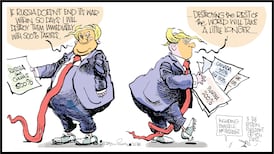Plymouth Rock is Ken Starr's kind of place. Marking the spot on the Massachusetts shoreline where the Pilgrims - religious fundamentalists fleeing persecution in Europe - landed in 1620, this chunk of New England granite is at the centre of America's founding myth. Bill Clinton, on the other hand, would feel more at home in Jamestown, the steamy Virginia island settled by the English in 1607. The fathers of Virginia carried less ideological baggage: they came to get rich.
At Jamestown, they cultivated addictive tobacco, speculated in undeveloped land, intermarried with the natives and engaged in back-stabbing political intrigues that sometimes led to sudden death.
Appropriately enough, Jamestown is currently undergoing archaeological investigation. The dig, under the auspices of the Association for the Preservation of Virginia Antiquities, has already produced startling results.
Ulster Connections
The 1607 fort, long thought to have been washed into the James River, has been located.
Within the fort, archaeologists have identified the body of an original colonist, and the bullet that killed him. But the find that gripped this visitor's attention was a handful of pennies, with their harps and dates - 1601 and 1602 - still clearly visible through almost four centuries of verdigris.
Although unexpected, the discovery of Irish coins should not surprise us. The dates, neatly bracketing the Irish defeat at Kinsale, hold the clue.
The English colonisation of Virginia was both concurrent with, and in important respects modelled on, the Plantation of Ulster that followed the Nine Years War. The year 1607 marked both the Flight of the Earls from Ireland and the establishment at Jamestown of the first permanent English settlement in the New World. At least 42 members of the Virginia Company, the London corporation that sponsored the Jamestown settlement, had business and political interests in Ireland. Several leaders of the founding expedition had served in the Irish wars, and brought attitudes toward the Native Americans strongly coloured by prior experience with the native Irish.
The Irish connection took more concrete form in the design of the fort built at Jamestown for protection against the local Indians. Its triangular shape violated almost all the usual rules of 17th-century English military engineering. But it bore striking similarities to a triangle-like fort erected six years earlier by Lord Deputy Mountjoy on the banks of the Ulster Blackwater.
Francis Magnel
At least one of the original Jamestown colonists was an Irishman. Francis Magnel, the bearer of a surname closely associated with Co Cork, was a sailor whose later recollection of his exact date of arrival was perhaps deliberately vague.
Based on his documented departure from Jamestown, in April 1608, on a ship bound for England, and his intimate knowledge of events in the early colony, historians have concluded that Magnel merits inclusion among the earliest European settlers in Virginia.
Little is known of his work or duties in Virginia, or the reason for his leaving. But this simple sailor's life soon became much more interesting.
Back in Europe, Magnel's American adventure came to the attention of "Fr Patrick", an Irish priest who may have been Patrick Duff, chaplain to Hugh O'Neill, the exiled Earl of Tyrone. Fr Patrick passed Magnel into the care of Captain John Rath, the Drogheda-born skipper who carried the fleeing Irish earls to the Continent.
This intelligence network led Magnel to Madrid, where in July 1610 he gave the Spanish Court a deposition on the English colony at Jamestown. Although this occurred more than two years after leaving Virginia, the Irish sailor's report has been misinterpreted to suggest that he first went to Jamestown in an undercover capacity. Indeed, guides at Jamestown still commonly refer to Francis Magnel as "the Spanish spy".
American historians have also misinterpreted the Spanish phrase "en sulengua" to mean that Magnel gave his report in English. But the pre-eminent expert on the Irish in Spain, the late archivist Micheline Kerney Walsh, felt that Magnel more likely spoke in Irish, the language in which a 17th-century Cork sailor would have felt most comfortable. From Irish or English, the report was in turn translated into Castilian by Florence Conry, the exiled archbishop of Tuam who also vouched for Magnel's identity and veracity.
Dionis O'Conor
If Magnel was indeed one of the earliest documented Irish speakers in Virginia, the logical question is whether or not there was anyone else there with whom he could converse. Incomplete records prevent any definite conclusion. But in September 1608, five months after Magnel left, a tradesman whose name appears in the records as Dionis O'Conor reached Jamestown.
It is highly unlikely that O'Conor survived his Virginia experience. In the winter of 1609, a devastating famine reduced the population from 500 to 60 within six months.
The ongoing archaeological project at Jamestown may yet uncover O'Conor's remains. But positive identification of any particular burial as Irish is unlikely. The overall site is believed to include some 300 early 17th-century graves. Many of the dead were hastily interred at night, lest hostile Indians should realise how few of the English were still alive.
The Irish pennies scattered throughout the fort are also unlikely to be of help. Rather than reaching Jamestown in the pockets of Magnel or O'Conor, the harp-embossed coins are thought to have been shipped in bulk from the London mint.
At a time when all English coins were silver or gold, the Irish coppers served the Virginia colony as a cheap source of small change or as trinkets for trade with the local Indians.










